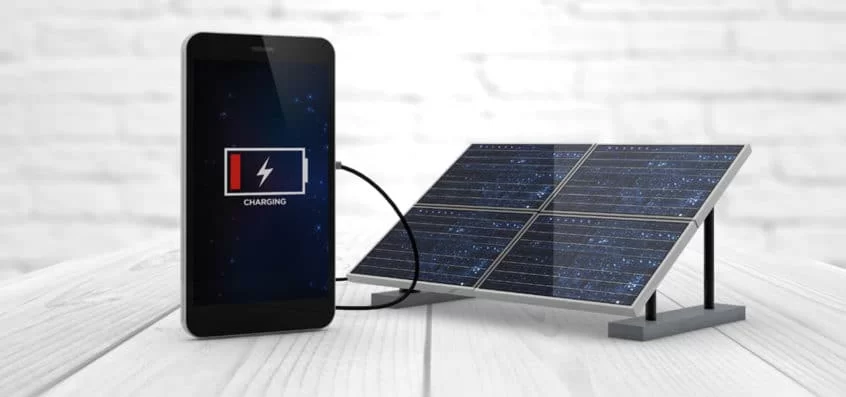When you turn on a light at home or at work, you are consuming energy. But what if turning on the light also meant generating energy?
Solar, or photovoltaic (PV), cells fixed to roofs convert sunlight into electricity; however, bringing that technology indoors could improve building energy efficiency and energize swaths of wireless smart technologies like smoke alarms, cameras, and temperature sensors, also known as the Internet of Things (IoT) devices.
Now, according to new research from the National Institute of Standards and Technology (NIST), a simple method for collecting light indoors may be within reach. Researchers from the National Institute of Standards and Technology (NIST) evaluated the indoor charging capabilities of tiny modular PV devices made of various materials, then connected the lowest efficiency module, built of silicon, to a wireless temperature sensor.

The team’s findings, which were published in the journal Energy Science & Engineering, show that the silicon module delivered more power than the sensor consumed during operation by absorbing just light from an LED. This result implies that the gadget may function indefinitely when the lights are turned on, eliminating the need for someone to manually replace or recharge the battery.
The team’s findings, which were published in the journal Energy Science & Engineering, show that the silicon module delivered more power than the sensor consumed during operation by absorbing just light from an LED. This result implies that the gadget may function indefinitely when the lights are turned on, eliminating the need for someone to manually replace or recharge the battery.
During the day, most buildings are illuminated by a combination of natural and artificial light sources. At night, the latter might keep providing power to gadgets. However, light from popular indoor sources, such as LEDs, has a narrower spectrum than light emitted by the sun, and certain solar cell materials are better than others at collecting these wavelengths.
Shore and his colleagues examined PV micro modules composed of gallium indium phosphide (GaInP), gallium arsenide (GaAs) — two materials targeted toward white LED light — and silicon, a less efficient but more inexpensive and ubiquitous material, to see how they stacked up.
The researchers placed the centimeters-wide modules underneath a white LED, housed inside an opaque black box to block out external light sources. The LED produced light at a fixed intensity of 1000 lux, comparable to light levels in a well-lit room, for the duration of the experiments. For the silicon and GaAs PV modules, soaking in indoor light proved less efficient than sunshine, but the GaInP module performed far better under the LED than sunlight. Both the GaInP and GaAs modules significantly outpaced silicon indoors, converting 23.1% and 14.1% of the LED light into electrical power, respectively, compared with silicon’s 9.3% power conversion efficiency.
The researchers were not surprised by the results of a charging test in which they measured how long it took the modules to charge a half-charged 4.18-volt battery, with silicon coming in last by almost a day and a half.
Considering the Consequences of Purchasing Used Smart Home Devices
Shore said the team wanted to see if the silicon module could generate enough power to run a low-demand IoT device despite its poor performance compared to the top-shelf competition.
Their IoT device of choice for the next experiment was a temperature sensor that they hooked up to the silicon PV module, placed once more under an LED. Upon turning the sensor on, the researchers found that it was able to feed temperature readings wirelessly to a computer nearby, powered by the silicon module alone? After two hours, they switched off the light in the black box and the sensor continued to run, its battery depleting at half the rate it took to charge.
“Even with a less efficient mini-module, we found that we could still supply more power than the wireless sensor consumed,” Shore said.
The researchers’ findings suggest that an already ubiquitous material in outdoor PV modules could be repurposed for indoor devices with low-capacity batteries. The results are particularly applicable to commercial buildings where lights are on around the clock. But how well would PV-powered devices run in spaces that are only lit intermittently throughout the day or shut off at night? And how much of a factor would ambient light pouring in from outside be? Homes and office spaces aren’t black boxes after all.
The team plans to tackle both questions, first by setting up light-measuring devices in NIST’s Net-Zero Energy Residential Test Facility to gain an understanding of what light is available throughout the day in an average residence, Shore said. Then they’ll replicate the lighting conditions of the net-zero house in the lab to find out how PV-powered IoT devices perform in a residential scenario.
Feeding their data into computer models will also be important for predicting how much power PV modules would produce indoors given a certain level of light, a key capability for cost-effective implementation of the technology.
Story Source:
Materials provided by the National Institute of Standards and Technology (NIST). Note: Content may be edited for style and length.
Home Automation >> News & Updates >> Smart Devices Can Be Powered Indoors Using Common Solar Technology